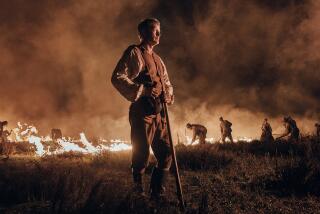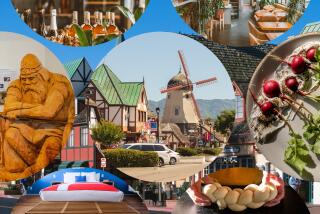By bicycle, an up-close visit to Denmark’s Funen island
- Share via
COPENHAGEN — While this year’s Tour de France cyclists struggled to overcome rain, cold and hills, I took a four-day bike trip in Denmark, one of the most cycle-friendly nations in the world. It has more than 7,000 miles of safe, interconnected, sign-posted bike trails and -- get this -- no big hills.
My 50-mile trip was hardly as long or as arduous as the Tour. I never tried to go fast because I wasn’t competing for the yellow jersey. I went riding for the fine food and beautiful scenery, both of which I found on the island of Funen.
Funen is wedged between the Jutland peninsula and Zealand island (home to Copenhagen) and is considered the garden of Denmark, a tapestry of woodlands, meadows, manor houses and sleepy villages with half-timbered houses.
Its farms and fisheries produce rich dairy products, raspberries, cherries, fiord shrimp and other fresh ingredients prized by a new generation of chefs who are putting Danish cuisine on Europe’s gastronomical map. (Copenhagen alone has 13 Michelin-starred restaurants.)
When I found a self-guided biking and dining tour on the Funen island tourist bureau website, I got hungry. The package had plenty going for it: deluxe accommodations for four nights in some of the island’s better hotels, big Danish breakfasts, three gourmet dinners, bike rental, luggage transport, cycling map and route descriptions.
The package -- four days of biking 15- to 20-mile stretches followed by three-course gourmet dinners -- operated more on the carrot than the stick principle. I do too, so I booked it, and before my Copenhagen-bound plane even got off the ground I could feel the wind in my hair.
Day 1
From Copenhagen, I took the train to Odense, my Funen departure point. The trip took a little more than an hour and crossed the 7.8-mile Great Belt Bridge between Zealand and Funen islands.
Odense may be the third-largest city in Denmark, but in a taxi from the train station to my first hotel, it looked more like a small town -- tidy, well-organized, with a pedestrian-only main street, a Gothic church, population of about 188,000 and a long canal leading to an inlet of the ocean.
The canal helped Odense become a manufacturing center, but its chief industry was born in 1805, when Hans Christian Andersen came into the world, the son of a washerwoman and shoemaker who lived in a hovel that’s now a popular tourist attraction.
I arrived at Knudsens Gaard Hotel, a Best Western motel near a gas station on the south side of town, built around an old farmstead with a cobblestone courtyard. My room in the new wing had contemporary furniture, a bed with a soft duvet and an unenclosed shower.
A sturdy bike with a front basket and attached lock had been left for me. I picked up my vouchers, map and route description at the front desk and claimed my first three-course dinner in the restaurant.
The waiter treated me handsomely, as did everyone once they found out I was a biker, which in Denmark is as good as traveling with a baby. When I sat down, he said the chef had prepared a special menu for me starting with fingers of catfish on a bed of wild rice in a triumph of a white wine sauce. The entree was pillow-soft veal surrounded by spring vegetables.
Then the waiter brought the kitchen’s special chocolate gateau, a cross between grandma’s devil’s food cake and creamy French fondant. Locked in a lifelong struggle with high-calorie desserts, I tried to eat just a few bites but couldn’t stop until only a smudge of chocolate remained.
Day 2
Up at 7 to fair skies and a traditional Danish breakfast buffet: eggs, bacon, yogurt, cereal, fruit, pastries, cheese, cold cuts and thick, square Danish brown bread. Despite the previous night’s dinner, I had an appetite, and nobody batted an eyelash when I made two sandwiches for lunch from the breakfast provender.
The first stage of the tour -- to Nyborg on the island’s east coast -- was an easy 20 miles. Figuring it wouldn’t take more than a few hours to get there, I spent the morning in Odense.
The summer sales were in progress on Vestergade Street downtown, and I found the front door open at St. Knud’s Church, a 13th century landmark built of patterned brick. St. Knud’s has two treasures: a huge, intricately carved altarpiece dating from the early 16th century and the skeletal remains of King Knud IV (or Canute), who was slain in 1086 and later became Denmark’s first saint.
I had to stop at Andersen’s birthplace, now an impressive modern museum. Its displays describe his impoverished childhood, theatrical writing, toothaches, travels and career as a storyteller, including such classics as “Thumbelina” and “The Emperor’s New Clothes.”
I ate a sandwich by the duck pond outside and headed for Nyborg on Route 6, an easy-to-follow path. Fields of summer wheat bordered by red poppies flowed by, then half-timbered farms built around courtyards, red Danish mailboxes, village churches with stepped gables.
Nyborg was much like Odense, but smaller, with a 13th century brick castle where I stopped for a cup of hot tea and directions to the Hotel Hesselet.
The hotel, on one of Nyborg’s pristine beaches, was a delightful surprise, blending modern Danish and Japanese styles with a beautiful collection of landscapes by late 19th century Funen Island School painters.
I was given an elegant room with a view of the beach and the silver spires of the Great Belt Bridge beyond it. At dinner in the formal restaurant the maitre d’ showed me to a table close to the picture window.
The meal -- another catfish starter, followed by roulade of guinea fowl entree and strawberry mousse for dessert -- was good, but the view was better. I watched people strolling along the beachfront path, a young couple holding hands on the pier and kids, just excused from the dinner table, running in circles on the grass.
Day 3
I nudged open the drapes the next morning to full sun on a sparkling sea and had a selection from the breakfast buffet delivered, along with a pot of hot, rich Danish coffee.
Back in the saddle again, I found Stage 2 of the Tour de Funen from Nyborg to the fishing village of Kerteminde the most delightful. The 16-mile route went north along the coast, past summer houses edged by giant hollyhocks and through shady woods, then emerged into sunlight and farmland with the sea just over the horizon.
There were manor houses reached by avenues of stately trees and unmanned farm stands operating on the honor system, selling fresh raspberries and broad beans.
Once I crossed the bridge leading into Kerteminde, I easily found the old-fashioned Tornoes Hotel. My small second-floor room had two dormer windows overlooking the harbor. I cleaned up and set out to explore.
First stop: Kerteminde’s popular ice cream shop, where you can watch a girl make cones on a waffle iron.
I went to the nearby town aquarium, then walked along the fiord to the Johannes Larsen Museum. Larsen was a founding member of the Funen Island School, which favored Impressionist, almost primitive landscapes. The complex includes the painter’s pretty whitewashed house built in 1901, airy studio and a modern building full of Funen School art.
Dinner that night was at the Restaurant Rudolf Mathis, considered one of the island’s best. It was right on the harbor and has seating in an elegant dining room and on the pier.
The waiter brought a tiny tureen of gazpacho as an amuse bouche. I started with Norwegian lobster in a light garlic-butter sauce, the second course was delicious breaded hake with baby shrimp, followed by the perfect finish: coffee and chocolates.
Day 4
The next morning brought a hint of rain, though it held off most of the way back to Odense. I passed handsome Ulriksholm Manor built in 1616 and a museum in the village of Ladby, where a 1,000-year-old ship, thought to be the grave of a Viking prince, was found in a field in 1934.
I finished the 16 miles of Stage 3 easily and spent the afternoon lazing at the Hotel Knudsens Gaard.
I honestly could have managed the whole tour in a day, but then there’d have been only one gourmet dinner.
--
--
(BEGIN TEXT OF INFOBOX)
If you go
THE BEST WAY TO FUNEN
From LAX, connecting service (change of plane) to Copenhagen is offered on Delta, British, Air France, KLM, Lufthansa, Swiss, Continental, United, American, with frequent connections on SAS. Restricted round-trip fares begin at $900.
Odense can be reached by train from Copenhagen.
THE BIKE TOUR
I booked my Luxury Bike Tour of Funen from the island’s visitors bureau, 011-45-62-21-09-80, www.visitsydfyn.dk. It included accommodations for four nights, breakfasts, three gourmet dinners, bike rental, luggage transport and more for about $1,600, which includes a single supplement.
TELEPHONES
To call the numbers listed below from the U.S., dial 011 (the international dialing code), 45 (the country code for Denmark) and the number.
WHERE TO STAY
Hotel Hesselet, 119 Christianslundsvej, Nyborg; 65-31-30-29, www.hesselet.dk. Doubles start around $330, including breakfast.
Hotel Knudsens Gaard, 2 Hunderupgade, Odense; 63-11-43-11, www.knudsensgaard.dk. Doubles start around $150, including breakfast.
Tornoes Hotel, 2 Strandgade, Kerteminde, 65-32-16-05, www.tornoeshotel.dk, In summer doubles start around $200, including breakfast.
WHERE TO EAT
Two of my dinners were at the restaurants in the Hotel Hesselet and the Hotel Knudsens Gaard; three courses about $85.
The most memorable meal was at Restaurant Rudolf Mathis, 13 Dosseringen, Kerteminde; 65-32-32-33, www.rudolf-mathis.dk,; four courses $122.
TO LEARN MORE
VisitDenmark, (212) 885-9700, www.visitdenmark.com.
More to Read
Sign up for The Wild
We’ll help you find the best places to hike, bike and run, as well as the perfect silent spots for meditation and yoga.
You may occasionally receive promotional content from the Los Angeles Times.






